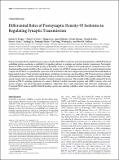| dc.contributor.author | Kruger, Juliane M. | |
| dc.contributor.author | Favaro, Plinio D. | |
| dc.contributor.author | Liu, Mingna | |
| dc.contributor.author | Kitlinska, Agata | |
| dc.contributor.author | Huang, Xiaojie | |
| dc.contributor.author | Raabe, Monika | |
| dc.contributor.author | Akad, Derya S. | |
| dc.contributor.author | Liu, Yanling | |
| dc.contributor.author | Urlaub, Henning | |
| dc.contributor.author | Dong, Yan | |
| dc.contributor.author | Xu, Weifeng | |
| dc.contributor.author | Schluter, Oliver M. | |
| dc.date.accessioned | 2014-09-02T18:10:09Z | |
| dc.date.available | 2014-09-02T18:10:09Z | |
| dc.date.issued | 2013-09 | |
| dc.date.submitted | 2013-08 | |
| dc.identifier.issn | 0270-6474 | |
| dc.identifier.issn | 1529-2401 | |
| dc.identifier.uri | http://hdl.handle.net/1721.1/89137 | |
| dc.description.abstract | In the postsynaptic density of glutamatergic synapses, the discs large (DLG)-membrane-associated guanylate kinase (MAGUK) family of scaffolding proteins coordinates a multiplicity of signaling pathways to maintain and regulate synaptic transmission. Postsynaptic density-93 (PSD-93) is the most variable paralog in this family; it exists in six different N-terminal isoforms. Probably because of the structural and functional variability of these isoforms, the synaptic role of PSD-93 remains controversial. To accurately characterize the synaptic role of PSD-93, we quantified the expression of all six isoforms in the mouse hippocampus and examined them individually in hippocampal synapses. Using molecular manipulations, including overexpression, gene knockdown, PSD-93 knock-out mice combined with biochemical assays, and slice electrophysiology both in rat and mice, we demonstrate that PSD-93 is required at different developmental synaptic states to maintain the strength of excitatory synaptic transmission. This strength is differentially regulated by the six isoforms of PSD-93, including regulations of α-amino-3-hydroxy-5-methyl-4-isoxazole propionic acid (AMPA) receptor-active and inactive synapses, and activity-dependent modulations. Collectively, these results demonstrate that alternative combinations of N-terminal PSD-93 isoforms and DLG-MAGUK paralogs can fine-tune signaling scaffolds to adjust synaptic needs to regulate synaptic transmission. | en_US |
| dc.description.sponsorship | National Institute of Mental Health (U.S.) (MH080310) | en_US |
| dc.language.iso | en_US | |
| dc.publisher | Society for Neuroscience | en_US |
| dc.relation.isversionof | http://dx.doi.org/10.1523/jneurosci.0019-12.2013 | en_US |
| dc.rights | Article is made available in accordance with the publisher's policy and may be subject to US copyright law. Please refer to the publisher's site for terms of use. | en_US |
| dc.source | Society for Neuroscience | en_US |
| dc.title | Differential Roles of Postsynaptic Density-93 Isoforms in Regulating Synaptic Transmission | en_US |
| dc.type | Article | en_US |
| dc.identifier.citation | Kruger, J. M., P. D. Favaro, M. Liu, A. Kitlinska, X. Huang, M. Raabe, D. S. Akad, et al. “Differential Roles of Postsynaptic Density-93 Isoforms in Regulating Synaptic Transmission.” Journal of Neuroscience 33, no. 39 (September 25, 2013): 15504–15517. | en_US |
| dc.contributor.department | Massachusetts Institute of Technology. Department of Brain and Cognitive Sciences | en_US |
| dc.contributor.department | Picower Institute for Learning and Memory | en_US |
| dc.contributor.mitauthor | Liu, Mingna | en_US |
| dc.contributor.mitauthor | Xu, Weifeng | en_US |
| dc.relation.journal | Journal of Neuroscience | en_US |
| dc.eprint.version | Final published version | en_US |
| dc.type.uri | http://purl.org/eprint/type/JournalArticle | en_US |
| eprint.status | http://purl.org/eprint/status/PeerReviewed | en_US |
| dspace.orderedauthors | Kruger, J. M.; Favaro, P. D.; Liu, M.; Kitlinska, A.; Huang, X.; Raabe, M.; Akad, D. S.; Liu, Y.; Urlaub, H.; Dong, Y.; Xu, W.; Schluter, O. M. | en_US |
| dc.identifier.orcid | https://orcid.org/0000-0001-7060-0288 | |
| dc.identifier.orcid | https://orcid.org/0000-0003-0096-2288 | |
| mit.license | PUBLISHER_POLICY | en_US |
| mit.metadata.status | Complete | |

